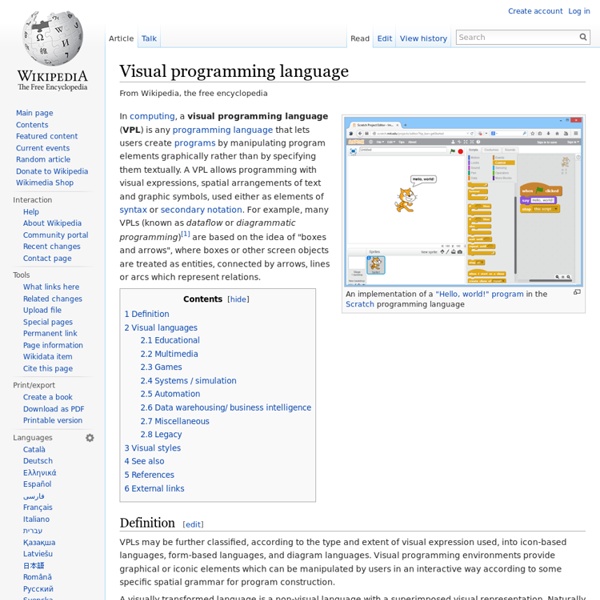Zoom
Trash
Related:



Prolog Prolog is a general purpose logic programming language associated with artificial intelligence and computational linguistics.[1][2][3] Prolog has its roots in first-order logic, a formal logic, and unlike many other programming languages, Prolog is declarative: the program logic is expressed in terms of relations, represented as facts and rules. A computation is initiated by running a query over these relations.[4] The language was first conceived by a group around Alain Colmerauer in Marseille, France, in the early 1970s and the first Prolog system was developed in 1972 by Colmerauer with Philippe Roussel.[5][6] Prolog was one of the first logic programming languages,[7] and remains the most popular among such languages today, with many free and commercial implementations available. Prolog is well-suited for specific tasks that benefit from rule-based logical queries such as databases searching, voice control systems, and template filling. §Syntax and semantics[edit] §Data types[edit] ? ? ? ?
L'École numérique » Créer des jeux vidéo en classe : des outils simples d’accès La création simple de jeux vidéo On associe généralement la création de jeux vidéo à des équipes constituées de centaines de professionnels dotés de solides compétences en programmation informatique et en création d’images de synthèse. Travaillant de 12 à 18 mois d’affilée sur un seul titre, ils réalisent des jeux vidéo à la pointe de la technologie qui seront ensuite commercialisés auprès du grand public. Si cette description correspond bien à la « création de jeux vidéo », il ne s’agit cependant que de la vision industrielle de cette activité. Dans l’ombre de ces professionnels surmédiatisés, de nombreux amateurs créent également des jeux vidéo, seuls ou en petit groupe. Créer des jeux vidéo en contexte pédagogique ? Si des outils rendent possible la création de jeux vidéo à l’école, on peut se demander quel serait l’intérêt pédagogique d’une telle activité. Écrire pour créer : la fiction interactive (Logiciels similaires à Quandary) La création de jeux vidéo avec graphismes 2D
OPS5 The OPS (said to be short for "Official Production System") family was developed in the late 1970s by Charles Forgy while at Carnegie Mellon University. Allen Newell's research group in artificial intelligence had been working on production systems for some time, but Forgy's implementation, based on his Rete algorithm, was especially efficient, sufficiently so that it was possible to scale up to larger problems involving hundreds or thousands of rules. OPS5 uses a forward chaining inference engine; programs execute by scanning "working memory elements" (which are vaguely object-like, with classes and attributes) looking for matches with the rules in "production memory". In this sense, OPS5 is an execution engine for a Petri net extended with inhibitor arcs. The OPS5 forward chaining process makes it extremely parallelizeable during the matching phase, and several automatic parallelizing compilers were created. OPS4 was an early version, while OPS83 came later. References[edit]
Mercury (programming language) The official implementation, the Melbourne Mercury Compiler, is available for most Unix platforms, including Mac OS X, as well as for Microsoft Windows. Mercury is based on the logic programming language Prolog. It has the same syntax, and the same basic concepts such as the SLD resolution algorithm. It can ostensibly be viewed as a pure subset of Prolog with strong types and modes. As such, it is often compared to its predecessor, both in terms of features, and run-time efficiency. The language is designed with software engineering principles in mind. Due to the use of information obtained at compile time (such as type and mode information), programs written in Mercury typically perform significantly faster than equivalent programs written in Prolog.[2][3] Its authors claim that Mercury is the fastest logic language in the world, by a wide margin.[1] Notable programs written in Mercury include the Mercury compiler itself and the Prince XML formatter. Production level: Beta quality:
Alice (software) Alice is a freeware object-based programming educational programming language with an integrated development environment (IDE). Alice uses a drag and drop environment to create computer animations using 3D models. The software was developed first at University of Virginia, then Carnegie Mellon (from 1997), by a research group led by the late Randy Pausch. Alice was developed to address three core problems in educational programming:[3] Most programming languages are designed to be usable for "production code" and thus introduce additional complexity. In controlled studies at Ithaca College and Saint Joseph's University looking at students with no prior programming experience taking their first computer science course, the average grade rose from C to B, and retention rose from 47% to 88%.[4] A variant of Alice 2.0 called Storytelling Alice[5] was created by Caitlin Kelleher for her PhD dissertation.[6] It includes three main differences: Learning to Program with Alice, Wanda P.
Jasper At the moment you have to go to different sites to connect to social networks. We think that things could be better and that they should come to you. Post to more than one network at the same time. Move images, music and more from one network to another. All from your own private, personalised site with no adverts and zero interference.